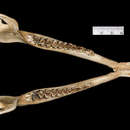Biology
provided by Arkive
Bay duikers are nocturnal animals (6) that shelter during the day in dense vegetation, in hollow trees or under fallen trunks (2), which makes them a difficult animal to study (4). They are known to primarily eat fruit (7), such as wild mango and African fruitbread (2), and thus are likely to play an important role as seed dispersers in the forest environment (8). Bay duikers also browse frequently on leaves (7), and surprisingly, this timid antelope is also known to occasionally stalk, kill and eat birds (2).
Duikers, as well as avoiding humans, do not even generally associate with each other. They live at very low densities (2), and usually occur alone, although sometimes they are seen in pairs (4), and are thought to be monogamous (4). The female gives birth to only a single calf, which hides among vegetation for the first few weeks, and spends very little time with the mother (4). The calf is weaned by five months of age, reaches sexual maturity around a year old, and has a lifespan of 10 to 12 years (9).
Conservation
provided by Arkive
The bay duiker is listed on Appendix II of the Convention on International Trade in Endangered Species (CITES), which means that international trade in this species should be carefully regulated (3). However, to address the threat of the unregulated bushmeat trade, further action is required. Research into the factors influencing the trade, and efforts to educate the public about the threats facing duikers and their importance, are some of the measures suggested (8). This is required to protect not only the future of bay duikers, but also to ensure this valuable resource is around for future generations of Africans.
Description
provided by Arkive
Duikers are small, shy antelopes which, while they do their best to avoid encountering humans, are being impacted by the unsustainable bushmeat trade. The name duiker comes from the Afrikaans word for 'diver', after their habit of diving for cover when disturbed (4). Bay duikers are fairly heavily built, with a coarsely textured red or yellowish-brown coat. A dark line runs along the back of the bay duiker, from the nose to the base of the tail, and a dark stripe may also run along the centre of the belly (2) (5) (6). The short forelegs and long hindlegs are black or dark brown (6). The head of the bay duiker is broader and flatter that in other duikers, with a short muzzle and eyes high on the head. This is due to its enlarged cheek muscles, an adaptation for efficient chewing action (2). Bay duikers have very short, conical horns, and underneath each of the eyes is a large scent gland, thought to be used to mark their territories (6).
Habitat
provided by Arkive
Bay duikers generally inhabit rainforest, where they can shelter in hollow trees, under fallen trunks and in dense thickets (2). They seem to have a preference for primary rainforest, and appear to be more common in areas where no forest destruction has taken place (6).
Range
provided by Arkive
Occurs in the equatorial lowland forest belt of Africa, from Senegal to Lake Tanganyika (2).
Status
provided by Arkive
Classified as Least Concern (LC) on the IUCN Red List (1), and listed on Appendix II of CITES (3).
Threats
provided by Arkive
The bay duiker has a very large distribution but its popularity with bushmeat hunters and traders has resulted in numbers declining in many West African countries. The bay duiker is now rare in Nigeria and Sierra Leone and extinct in Uganda (2). Duikers are easily hunted with either gun or cable snare, easily transportable by foot, and have sufficient meat to be profitable, making them one of the primary targets for both subsistence and commercial hunting activities (8). Unfortunately, the majority of duiker hunting at present is unsustainable (8). In addition, the bay duiker's preference for undisturbed forest makes is vulnerable to habitat degradation, caused by human activities such as cultivation. For example, population numbers in Togo are declining due to a combination of habitat destruction and hunting (6).

